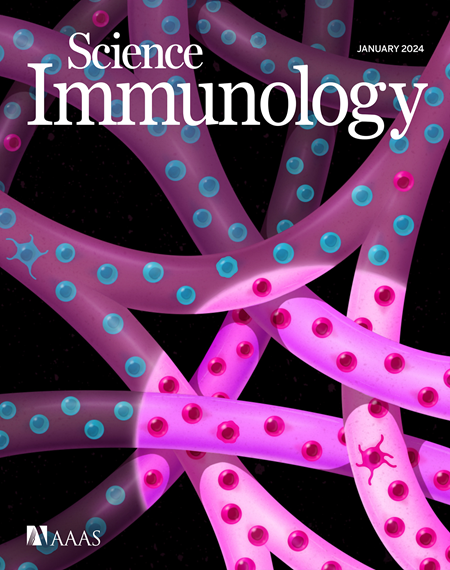动态STING抑制协调免疫细胞的发育和功能
IF 17.6
1区 医学
Q1 IMMUNOLOGY
引用次数: 0
摘要
STING是先天免疫系统的重要组成部分,但稳态STING的表达模式和调控尚不清楚。利用STING 1 IRES-EGFP报告基因和条件型STING 1转基因小鼠,我们发现STING表达调控对免疫细胞发育和功能至关重要。中性粒细胞抑制STING表达,强迫STING表达或信号驱动全身性炎性疾病。在T淋巴细胞发育过程中,DNA甲基转移酶1通过表观遗传沉默将STING的表达限制在双阳性阶段。强迫STING表达或信号传导受损的T淋巴细胞发育不依赖于I型干扰素,并促进了先天样γδ T细胞的谱系承诺,而不是适应性αβ T细胞。在肿瘤微环境中,CD8 + T淋巴细胞抑制STING表达,与同基因小鼠肿瘤和人类结直肠癌中T细胞耗竭的特征相关。我们的数据证明了控制而不是普遍存在的STING表达的必要性,揭示了以前未被认识的STING病理生物学维度。本文章由计算机程序翻译,如有差异,请以英文原文为准。
Dynamic STING repression orchestrates immune cell development and function
STING is an essential component of the innate immune system, yet homeostatic STING expression patterns and regulation are unknown. Using Sting1 IRES-EGFP reporter and conditional Sting1 transgenic mice, we found that regulation of STING expression is critical for immune cell development and functionality. STING expression was repressed in neutrophils, and forced STING expression or signaling drove systemic inflammatory disease. During T lymphocyte development, STING expression was restricted at the double-positive stage via epigenetic silencing by DNA methyltransferase 1. Forced STING expression or signaling impaired T lymphocyte development independent of type I interferon and promoted lineage commitment to innate-like γδ T cells over adaptive αβ T cells. In the tumor microenvironment, CD8 + T lymphocytes repressed STING expression, correlating with features of T cell exhaustion in syngeneic mouse tumors and human colorectal cancer. Our data demonstrate the necessity of controlled, rather than ubiquitous, STING expression, uncovering a previously unappreciated dimension of STING pathobiology.
求助全文
通过发布文献求助,成功后即可免费获取论文全文。
去求助
来源期刊

Science Immunology
Immunology and Microbiology-Immunology
CiteScore
32.90
自引率
2.00%
发文量
183
期刊介绍:
Science Immunology is a peer-reviewed journal that publishes original research articles in the field of immunology. The journal encourages the submission of research findings from all areas of immunology, including studies on innate and adaptive immunity, immune cell development and differentiation, immunogenomics, systems immunology, structural immunology, antigen presentation, immunometabolism, and mucosal immunology. Additionally, the journal covers research on immune contributions to health and disease, such as host defense, inflammation, cancer immunology, autoimmunity, allergy, transplantation, and immunodeficiency. Science Immunology maintains the same high-quality standard as other journals in the Science family and aims to facilitate understanding of the immune system by showcasing innovative advances in immunology research from all organisms and model systems, including humans.
 求助内容:
求助内容: 应助结果提醒方式:
应助结果提醒方式:


